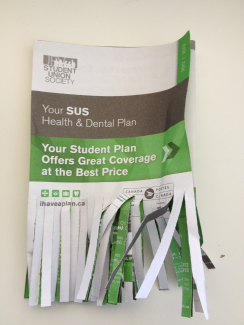By Dessa Bayrock (The Cascade) – Email
Print Edition: July 3, 2013
 Students will notice a drop in their health and dental coverage when they return to campus in the fall.
Students will notice a drop in their health and dental coverage when they return to campus in the fall.
Late last month, the Student Union Society (SUS) dental from 75 per cent to 55 per cent, and dropped eyewear coverage to zero, although optometrist fees are still covered by the plan.
Medical coverage will continue to cover costs at current levels of up to 70 per cent for eligible prescriptions.
These cuts come after a referendum to raise the health and dental fee failed earlier this year. Students currently pay $159.92 a year, and the referendum proposed an increase to $229.92 annually. A second referendum question proposed tying the fee to inflation, and allowing SUS to increase the fee at a set rate of five per cent per year.
As SUS president Shane Potter explains, students faced a choice between an increase in fees and a decrease in service.
“Every year that the fee doesn’t go up, the health and dental services have to be cut,” he says. “We have not had an increase for many years now, and we are seeing the effect.”
Potter also notes that the number of students claiming health and dental benefits from the program has drastically increased since its inception, which strains the limited funding pool.
“Our students are also using the program a lot more, which is good, but again pushes the reason for the fee to rise,” he explains. “We want to keep fees as low as possible, but on the other hand, the purpose of the health and dental program … is to provide extended health coverage for those who would not be able to afford it.”
Potter hopes that SUS will be able to increase coverage again in the fall after passing another referendum. The first step in that journey is reaching out to students; Potter has visions of surveys, open houses and a plethora of student feedback to help form the referendum question itself.
“The priority is a clear referendum question that allows a reasonable increase that balances the costs with the needs,” Potter says.
He also notes that he feels the previous referendum question was unclear.
“I don’t think this issue has been communicated effectively in the past,” Potter concludes. “We are member-driven, but we also have to be clear in our information that these programs help people who would not be able to afford much needed medical and dental coverage.”


